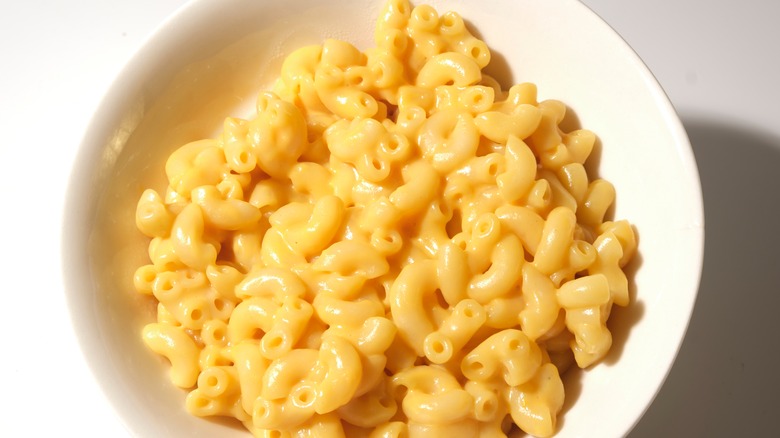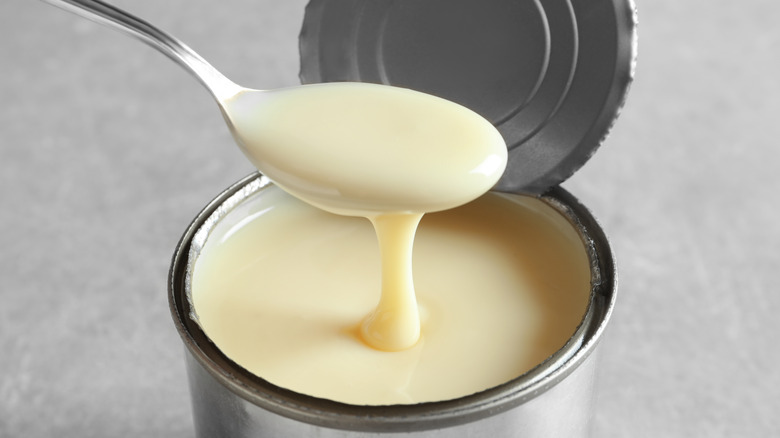Make Mac And Cheese With Evaporated Milk For A Truly Velvety Experience
The creamier the macaroni and cheese, the better, at least in the eyes (and palates) of a lot of folks — especially when it's made on the stovetop. That smooth, cheesy, ooey-gooey sauce folded into plenty of tender pasta makes for arguably the ultimate comfort food that warms both the heart and belly. Achieving that perfectly velvety cheese sauce texture can be a challenge, though, and if you're building it from scratch by making a roux it can take a long time (and a lot of care and effort to avoid lumps). There's a simpler way to get your stovetop mac and cheese nice and creamy, and it starts with a can of evaporated milk.
Using evaporated milk in your macaroni and cheese not only results in a delectably smooth sauce, but it helps get dinner on the table faster. In approximately 10 minutes, you can whip up a pot of cheesy pasta that far surpasses any version made from a blue box. The secret to the sauce's silky texture is evaporated milk's natural powers of emulsification: The ingredient is full of protein micelles, which work to hold cheese sauces together from pot to bowl to mouth. Combine the warm evaporated milk with a little starchy pasta water and a blend of meltable cheeses, and you've got the creamiest mac and cheese you might ever eat.
What is evaporated milk?
Before you pour a can of evaporated milk directly into your pot of pasta, you might want to know what it is. Evaporated milk is fresh milk that has been simmered down, evaporating off around 60% of its moisture until it becomes a viscous, creamy substance that is even thicker than heavy cream. Canned evaporated milk is then homogenized before being sealed and sterilized, leaving it shelf-stable for up to two years and ready to be incorporated into any recipe, sweet or savory, that could benefit from an extra creamy texture.
Evaporated milk can be used as-is in place of half-and-half in recipes, or can be mixed with water to thin it out, making it an ideal substitute for fresh milk. One can of evaporated milk can be reconstituted with 1½ cans of water; combine thoroughly and use anywhere milk is called for. For extra-creamy mac and cheese, though, leave your can undiluted.
One more tip: For a savory recipe like macaroni and cheese, don't reach for condensed milk. The difference between evaporated milk and condensed milk is the addition of sugar. The condensed version has been sweetened, and it's extremely sugary (up to 45% sugar by weight). Unless you want your mac and cheese to taste like cake frosting, be sure to choose the correct option.
Cheeses for an extra-creamy mac and cheese
Although evaporated milk can certainly help provide a smooth and creamy texture to your next pot of mac and cheese, adding the right cheeses can also contribute not just to mouthfeel, but to taste. You want to pick cheeses that mesh well together taste-wise and that melt easily; otherwise, you could end up with a gritty or chunky sauce.
Many recommend gruyère as a prime mac and cheese ingredient, as this Swiss cheese melts down smooth, imparts a delectably nutty flavor, and pairs well with other cheeses. Gruyère is an Alpine cheese; cheeses made in this fashion are treated with less salt, which helps them melt more easily and smoothly. This is especially important when adding evaporated milk to the sauce, as this cooking method is fast and uses fewer ingredients.
Cheddar is another common mac-and-cheese choice, and there's a good reason why. Cheddar (especially sharp cheddar) melts well, tends to be relatively inexpensive, and provides a delicious and recognizable flavor to your mac that's as comforting as it is delicious. Just be sure to buy the block and shred it yourself; pre-shredded cheese isn't recommended for macaroni and cheese, as it can contain extra ingredients that can cause clumping and prevent your cheese from melting into a silky, homogenized sauce.


